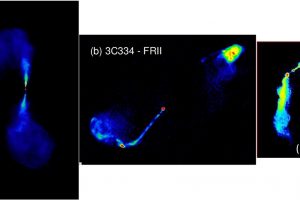Morfologia ed ambiente delle radiogalassie. L’articolo: “Investigating the large-scale environment of wide-angle tailed radio galaxies in the local Universe” di V. Missaglia (UniTo, OATo) pubblicato su A&A

Le radiogalassie sono galassie caratterizzate da un’intensa emissione di onde radio, principalmente generata da particelle relativistiche in moto all’interno di campi magnetici (fenomeno noto come emissione di sincrotrone). Tale fenomeno trova origine nell’attività del buco nero posizionato al centro della galassia, il quale alimenta getti di gas ad altissima energia che si estendono su distanze di migliaia o persino milioni di anni luce. In base a una classificazione formulata nel 1974, le radiogalassie possono essere suddivise in due categorie: le Fanaroff–Riley di tipo I (FR I) e le Fanaroff–Riley di tipo II (FR II). La distinzione tra queste due categorie risiede nell’intensità dell’emissione radio man mano che ci si allontana dal centro galattico: nelle FR I, la luminosità diminuisce, mentre nelle FR II essa aumenta progressivamente avvicinandosi ai lobi del getto emesso dal buco nero. Seguendo un approccio analogo, alcune galassie possono essere classificate come “galassie radio a coda ad angolo ampio” (WATs), le quali presentano una morfologia più complessa nelle onde radio, dove i getti emittenti terminano con una caratteristica forma a “c”.
La distinzione tra le FR I e le FR II, oltre a essere di natura morfologica, cela una differenza sia in termini evolutivi che ambientali. Le FR I sono di solito osservate al centro di ricchi gruppi o ammassi di galassie, mentre le FR II sono tipicamente più isolate. La morfologia delle galassie WAT, anch’esse di solito osservate al centro di ammassi di galassie e spesso associate alle galassie più luminose all’interno degli ammassi stessi, suggerisce un’intensa interazione con l’ambiente circostante. La loro forma può infatti essere modellata dalla pressione esercitata sui getti da parte del mezzo intergalattico circostante, in movimento rispetto alla galassia, oppure dall’evoluzione dinamica di galassie in collisione.
Il gruppo di ricercatori guidato dall’astrofisica Valentina Missaglia (Università degli Studi di Torino, INAF – Osservatorio Astrofisico di Torino, INFN e Foundation for Research and Technology – Hellas) ha condotto un’analisi su tre cataloghi omogenei di galassie FRI, FRII eWAT nell’Universo Locale, con l’obiettivo di studiarne l’ambiente circostante e confrontarne le proprietà per le tre categorie. A tal fine, il team di ricerca ha utilizzato il catalogo derivato dalle osservazioni della campagna SDSS (Sloan Digital Sky Survey) per individuare galassie prossime alle WAT oggetto dell’analisi. Lo studio conferma l’abitudine delle radiogalassie WAT a occupare principalmente il nucleo di ricchi gruppi e ammassi di galassie, in accordo con il paradigma generale per cui le WAT rappresentano le galassie più luminose dei gruppi o ammassi in cui risiedono. Inoltre, le WAT si trovano in ambienti con un numero di galassie sistematicamente maggiore rispetto a quello trovato per le FR I e FR II. Infine, per il range di distanze considerato in questa ricerca, le WAT risiedono in ambienti di dimensioni simili (in termini di massima distanza delle galassie che appartengo al gruppo/ammasso) a prescindere dalla loro distanza da noi, risultato che non si osserva per le FR I e le FR II. I risultati di questo studio sono descritti nell’articolo intitolato: “Investigating the large-scale environment of wide-angle tailed radio galaxies in the local Universe“, recentemente pubblicato sulla rivista Astronomy & Astrophysics. Tra i coautori dell’articolo figura anche l’astrofisico I. Pillitteri dell’INAF – Osservatorio Astronomico di Palermo.
La figura (cliccare qui per visualizzarla interamente) mostra tre immagini ottenute con il Very Large Array (VLA) di radiogalassie dei tre tipi discusse in questo studio: la galassia FR I M84; la FR II 3C334 e la WAT 3C465.
Mario Giuseppe Guarcello ( segui mariospiegacose) ( mariospiegacose)( follow mariospiegacose)
Segui la pagina Facebook e Instagram dell’Osservatorio Astronomico di Palermo
Iscriviti al canale Youtube dell’Osservatorio Astronomico di Palermo
